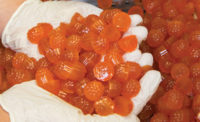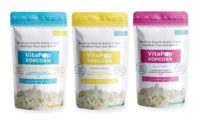Soft textures and bold flavors are making the gummy application the delivery method of choice for vitamins and supplements.
The global gummy vitamin market is projected to swell by a compound annual growth rate (CAGR) of 5.2 percent to $4.17 billion in 2025, according to a 2017 Transparency Market research report. The Albany, New York-based research firm valued the market at $2.68 billion in 2016.
Ease of consumption and variety in shape and color are driving growth in the gummy vitamin market, the firm noted.
“Gummy vitamins are dietary supplements which were originally formulated for children not wanting to take pills,” the report’s executive summary reads. “In no time, gummy vitamins gained popularity among children as well as adults because of their visual appeal and also because they are easy to ingest. Availability of gummy vitamins in different shapes, tastes and colors are some other factors stoking the growth of this market.”
Multivitamins account for the largest share of the market, and the segment will be supported by a comprehensive supply chain and distribution management, superior production facilities and innovative product offerings. The single-vitamin segment — which includes supplements for biotin, vitamin C, omega & DHA, CoQ10, vitamin D, melatonin and high-fiber formulas — is projected to flourish due to demand for vitamin D supplements among all age groups and rising use of omega-3 DHA among pregnant women.
However, side effects related to overconsumption of gummy vitamins could restrain growth of gummy vitamins market. Holger Brack, food engineer and head of product development of Winkler and Dünnebier Süßwarenmaschinen GmbH (WDS), says strict measures must be taken to make sure dosages of vitamins are precise.
“By adding substances that have an impact on the human organism, a "simple" and well-known confectionery production is over. Legal and hygienic requirements play a decisive role in producing such products," Brack says. “In addition to a high-precision cooking, dosing, cooling and demoulding process, research must also include a precise and documentable dosage of the additives, cleaning and avoidance of cross-contamination, also regarding the GMP (good manufacturing practices) of the plant.”
Nonetheless, increasing interest in longevity has led to rising demand for dietary supplements among consumers.
Transparency Market Research valued the North American gummy vitamin market — occupying the largest global share — at $1.11 billion, but that’s expected to rise by a CAGR of 5 percent to $1.64 billion by 2025. Health-conscious adults and the elderly, who want to boost their daily nutrient intake, have bolstered the market in the region.
Globally, the Asia-Pacific region is expected to show increasing demand for gummy vitamins as as awareness of dietary supplements expands. Transparency Market Research projected the Asia-Pacific gummy vitamin market will grow by a CAGR of 3.8 percent between 2017 and 2025.
Sirio Pharma Co. Ltd announced in 2018 its plans to build a 26,000-sq.-meter gummy production facility at its 240,000-sq.-meter plan in Ma’anshan, China. Featuring integrated research and development capabilities, the new facility was expected to push Sirio’s production capacity to 2.4 billion gummies per year. The company also expanded its offerings to include liquid-filled, center-filled, swirled and multi-colored gummies.
“As consumers become more discerning, we anticipate branded companies will increasingly need specialist gummy development partners and capabilities,” Sirio CEO Rui Yang said in a news release, also noting in the U.S. and Europe gummies are seen as a “consumer friendly” dosage form.
Nonetheless, the European gummy market trails North America, partially because of strict regulations for gummy vitamin supplements. However, innovation formulations are fanning growth, Transparency Market Research reported.
Gelatin and collagen supplier GELITA, Hänsel Processing and WDS have partnered to offer manufacturers the Fast Forward Process (FFP), a fast-setting starchless solution for producing gummies.
“Today, millions of consumers have turned to gummies as a convenient and healthy dietary supplement,” GELITA’s website reads. “So far these gelatine gummies are produced on regular mogul lines to achieve the desired texture, taste and bite. Although the ability to produce a variety of different shapes and sizes is a huge advantage of this processing method, there is also a massive downside: the combined use of active ingredients and starch can lead to cross-contamination.”
The new technology features an innovative gummy formulation from GELITA, a novel cooking process from Hänsel that’s adjusted to the new recipe, and a new WDS depositing line to handle the depositing. FFP shortens the gelatin gummy manufacturing time from one day to less than two hours and silicone moulds eliminates the need for starch.
“The absence of starch significantly reduces material handling and avoids dust, residues or cross-contamination when using different fortifications such as vitamins, minerals or other active ingredients in the formulation,” the GELITA website reads.
No matter which system manufacturers use, it's unlikely they'll stop at vitamins, WDS noted. Pharmaceutical companies are looking at using the gummy application for aspirin, acetaminophen, diclofenac, ginkgo and other over-the-counter medicines.
"This development places high demands on the manufacturing process, e.g. the precision of depositing, but also on hygienic design and easy accessibility for cleaning," WDS noted.





